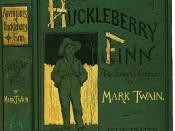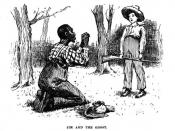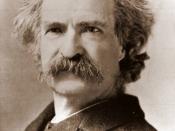Satire censures things, people, activities, or ideas, and makes people see things that they normally wouldn't permit to exist. Often times, satire is used to relay a message between an author and his reader. In The Adventures of Huckleberry Finn, Mark Twain uses satire to reveal faults in society. The humor he includes leaves his reader laughing at him or herself, and often times responding with a "That's me" statement. By the end of the novel, Twain hopes the satire in his novel has left an impression to encourage change. In The Adventures of Huckleberry Finn, Mark Twain uses satire to criticize romanticism and hypocrisy in society.
Mark Twain attacks romanticism. He uses the title Walter Scott, a romantic author, to name the "likely to break up and wash off" wrecked ship. By linking romanticism with the Walter Scott, Twain shows us the destruction, downfall, and sinking of both.
As a result of their dreams and lack of reality, romanticists walk down the path leading to danger and possible professional death just as a person on the ship heads in the direction of physical death. While at the Sunday school picnic, Tom Sawyer tried to kill "600 camels" with "swords and guns." Huck realizes that Tom lives in a dream world, and his camels were really children and his weapons were really broomsticks. Twain is against romanticists or those who fight problems that aren't really problems. Things will never get accomplished with romanticists. Tom Sawyer, the romanticists, does not care "how foolish (the rescue plan)" seems, as long as the two boys attempt the plan according to "the books". Tom put Jim, Huck, and himself in danger by attempting a fairy tale rescue, and Tom also knew and kept to himself the news that Jim had previously been...


